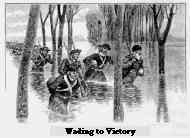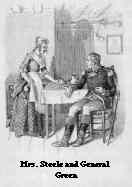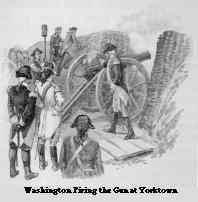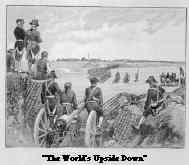Resource Center OLLibrary
|
1778 ] |
|
163 |
|
In the summer and autumn bands of
ferocious Iroquois (§ 32) led by Tory (§§
160, 165) captains committed horrible massacres at
Wyoming, Pennsylvania, and Cherry Valley, New York. |
|
164 |
|
[1779-1780 |
the southern states. "Mad Anthony Wayne,"1 under
Washington's direction, stormed and took the fort (July 15, 1779),
-- at midnight, at the point of the bayonet -- never firing a shot
during the battle. The capture of the fort stopped the British
plans for ravaging Connecticut. They found that they must use all
their forces to hold the Hudson.
The next autumn brought glorious news. Captain
Paul Jones,2 the first man to hoist the Stars and
Stripes (§ 179) over an American war ship, had, with the help
of Benjamin Franklin (§ 135), fitted out three or four
vessels in our defense. With three of these vessels, one of which
was a half-rotten old hulk, he boldly attacked and captured two
British men-of-war. The fight took place off Flamborough Head on
the east coast of England. (Map, p. 67.)
After that most humiliating defeat England still
boasted that she was "mistress of the seas," but the boast was in
a lower tone; if Paul Jones had only had a few more ships, he
would have made the tone a whisper.
184. The British take Charleston; Marion and
Sumter's Mode of Fighting. In the spring (1780) the war in the
South was renewed with vigor. The British took Charleston (May 12,
1780), and Lord Cornwallis (§ 171) held the city. But Marion
(§ 115) and Sumter, with their bands of resolute men armed
with a few guns, and weapons made of old scythes and saw blades,
did good service in the American cause. When the British forces
went out to conquer the country, the Carolina patriots attacked
them just as two kingbirds attack a hawk. The kingbirds are not
nearly as big and strong as the hawk, but they are far quicker.
They strike him from opposite sides. They easily dodge his blows,
but he cannot avoid theirs. So they worry and torment the hawk
until they tire him out, and he is glad to fly in any direction to
get away from them.
1 General Anthony
Wayne of Pennsylvania. He was called "Mad Anthony Wayne" on
account of his daring. The British thought that the Americans
could not use the bayonet; Wayne showed them their mistake.
2 Paul Jones was by birth a
Scotchman. He entered the American service in 1775. His name was
originally John Paul.
|
1780-1781 ] |
|
165 |
185. Loss of Camden; Brilliant Victory of
King's Mountain. The British had a small force at Camden (Map,
p. 162), South Carolina -- a great center for roads, and hence of
much importance from a military point of view. General Gates
(§ 179) with General De Kalb (§ 176) resolved to attempt
the capture of the place before Cornwallis could arrive there, but
Cornwallis reached Camden first. A battle was fought (August 16,
1780) in which Gates was compelled to retreat, losing artillery
and baggage, and narrowly escaping capture himself.
But while Cornwallis was chuckling over his
victory, the backwoodsmen of this part of the country,
sharpshooters, every man, attacked a British force at King's
Mountain (October 7, 1780), on the borders of North and South
Carolina, and in a terrible battle completely defeated the enemy.
(Map, p. 162.)
186. Arnold's Treason; the Dreadful Winter at
Morristown. Meanwhile (September 22, 1780), the most startling
and the saddest event of the Revolution occurred. Benedict Arnold
(§§ 164, 179), Washington's trusted friend, commander at
West Point, had turned traitor. The discovery was made through the
arrest of André, a British spy by whom Arnold attempted to
send a plan of the fort to the British commander at New York.
André was tried and hanged, but Arnold escaped to the
British army. Later, the traitor led an attack on Richmond,
Virginia, and burnt it, and, last of all, one on New London in his
native state of Connecticut.
Arnold died in London twenty years later. It is
said that the last request he made was that the epaulettes and
sword knot which Washington had given him might be brought. "Let
me die," said he, "in my old American uniform, in which I fought
my battles. God forgive me for ever having put on any other!"
The gloom of Arnold's awful act of treason was
felt in the American camp at Morristown (§ 182) in the
dreadful winter (1780-1781) which followed. In some respects it
was worse than that at Valley Forge (§ 181); and the men,
unpaid, half fed, freezing, were driven to desperation and partial
revolt.
|
166 |
|
[1781 |
|
187. Greene's Campaign in the
South (1781); the Incident at the Tavern; Cornwallis
leaves the Carolinas. But it was the gloom that
precedes the dawn. General Nathanael Greene of Rhode
Island had been placed in command at the South. Next to
Washington he was by far the ablest soldier in the
Revolution. With a little force that seemed, as he said,
but "the shadow of an army," he accomplished wonders. |
|
1781 ] |
|
167 |
At Guilford Court House (now Greensborough),
North Carolina, Cornwallis defeated the Americans (March 15,
1781), but he himself lost so heavily that he could not hold his
ground and had to retreat to Wilmington, North Carolina. He
arrived there (April 7, 1781) in miserable plight, having lost
about half of his small army by battle, sickness, or desertion. On
reaching Wilmington, Cornwallis heard that Greene had turned back
to attack the English force under Lord Rawdon left at Camden,
South Carolina. Cornwallis was in no condition to wheel about and
follow Greene. He finally decided to march northward to
Petersburg, Virginia. (Map, p. 162.) There he hoped to get more
troops from New York; then, having conquered Virginia, he would go
back and reconquer the Carolinas.
188. Greene's Campaign in South Carolina.
Cornwallis started on his long march of 200 miles. Meanwhile,
Greene, aided by Marion, Sumter (§ 184), and Pickens, had
driven the British from Camden (May 10, 1781). Through the summer
he struck the enemy blow after blow, and ended by gaining what was
practically a victory, at Eutaw Springs, South Carolina (September
8, 1781). After that the British -- what there was left of them --
fled to Charleston, shut themselves up there, and did not venture
out. Greene had in fact won back the Carolinas; and he had won
them, thanks to the help given by Marion, Sumter, and Pickens,
with an army which did not number more than about 2000 men. To
accomplish much with small means is a sure sign of greatness.
Greene had done this, and Washington was the man who taught
him.
189. The Crowning Victory of the War,
1781. Cornwallis reached Virginia, and after vainly pursuing
Lafayette (§§ 176, 179) and destroying millions of
dollars' worth of property he entered Yorktown, on a narrow
peninsula at the mouth of the York River. He went there not
because he wanted to, but because he must. Cornwallis had been
chasing Lafayette; he boastingly said, "The boy cannot escape me."
But "the boy," Lafayette, with a larger army, had turned round and
begun chasing him. Cornwallis moved to Yorktown (July 30, 1781) to
get
|
168 |
|
[1778 |
|
help by sea from New York. There the British general
fortified himself. He did not know it, but he was
building his own prison one that he would never get out
of except by surrender. |
|
1781 ] |
|
169 |
|
than a week against solid shot, shell, and red-hot
balls. Then, seeing that it was useless to struggle
against fate, he surrendered. His army marched out
October 19, 1781, to the tune of "The World's |
 In
the West, Captain George Rogers Clark of Virginia
accomplished wonders. He and his little band of stalwart
backwoodsmen set out to capture the enemy's forts
(1778-1779).
In
the West, Captain George Rogers Clark of Virginia
accomplished wonders. He and his little band of stalwart
backwoodsmen set out to capture the enemy's forts
(1778-1779). Early
in the year (January 17, 1781) a part of Greene's men,
led by Morgan (§ 179), gained the battle of Cowpens,
South Carolina. (Map, p. 162.) Then Greene, who was
master of the game he was now playing, retreated toward
Virginia, thus drawing Cornwallis, who followed him,
further and further away from his supplies at Charleston.
But the American general had many anxious days during
this retreat, and often the chances of success seemed
wholly against him.
Early
in the year (January 17, 1781) a part of Greene's men,
led by Morgan (§ 179), gained the battle of Cowpens,
South Carolina. (Map, p. 162.) Then Greene, who was
master of the game he was now playing, retreated toward
Virginia, thus drawing Cornwallis, who followed him,
further and further away from his supplies at Charleston.
But the American general had many anxious days during
this retreat, and often the chances of success seemed
wholly against him. While
he was waiting for soldiers to arrive from New York a
French fleet of war ships (§ 179) was coming to
block him in. Now was Washington's chance to strike a
tremendous blow. His plan was to march rapidly south from
the Hudson to Yorktown, and, with the help of the French
fleet and French troops and of Lafayette and his army, to
capture Cornwallis with his whole force. Such a move
required a large amount of money to pay the men and buy
provisions. Robert Morris (§ 175) again came to the
rescue and is said to have furnished nearly a million and
a half of dollars for the good work.
While
he was waiting for soldiers to arrive from New York a
French fleet of war ships (§ 179) was coming to
block him in. Now was Washington's chance to strike a
tremendous blow. His plan was to march rapidly south from
the Hudson to Yorktown, and, with the help of the French
fleet and French troops and of Lafayette and his army, to
capture Cornwallis with his whole force. Such a move
required a large amount of money to pay the men and buy
provisions. Robert Morris (§ 175) again came to the
rescue and is said to have furnished nearly a million and
a half of dollars for the good work. Upside
Down." It was true; the British world in America was
"upside down," and the fall of Yorktown practically ended
the War of the Revolution. After more than six weary
years of fighting Washington had conquered. It was "the
victory of a great and good man in a great and good
cause."
Upside
Down." It was true; the British world in America was
"upside down," and the fall of Yorktown practically ended
the War of the Revolution. After more than six weary
years of fighting Washington had conquered. It was "the
victory of a great and good man in a great and good
cause."


